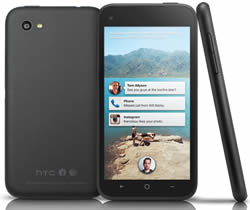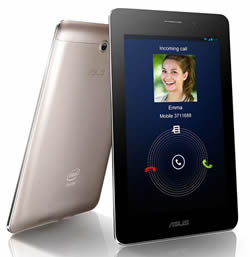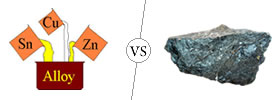Difference between HTC First and Asus FonePad
Key difference: HTC First is the first phone that will be released running on the Facebook Home user interface. The phone will be powered by a Qualcomm MSM8930 Snapdragon 400 1.4 GHz Dual-core Krait and a 1 GB of RAM. Asus has announced the launch of newest phablet, the Asus Fonepad. The Fonepad is a 7-inch Android tablet that allows users to also make phone calls by placing the device on their ear. The phablet runs on 1.2 GHz single-core Intel Atom processor, making it pretty fast for multi-tasking, along with playing some high-res games. The device has 1 GB RAM.
 In today’s world, social networking is more important that air of water. Some people might be able to get through without food, but not without checking their Facebook accounts at least a few times during the day. Facebook realizing the important part it plays in people’s social lives and recognizing the need for Facebook integration on mobile phones, has collaborated with HTC for new Facebook phone: the HTC First.
In today’s world, social networking is more important that air of water. Some people might be able to get through without food, but not without checking their Facebook accounts at least a few times during the day. Facebook realizing the important part it plays in people’s social lives and recognizing the need for Facebook integration on mobile phones, has collaborated with HTC for new Facebook phone: the HTC First.
HTC First is the first phone that will be released running on the Facebook Home user interface. This isn’t the first time that HTC and Facebook have collaborated. HTC has previously launched the ChaCha, Status, and Salsa, all of which had special Facebook integration, beyond the normal app. However, the HTC First will be the first to actually have a user interface (UI) based on Facebook.
The Facebook Home UI will consist of Cover Feed which will use the home screen and lock screen to show content posted by friends on Facebook, as well as notifications from other apps. It also has an overlay over any and all apps, which allow users the ability to message others via Facebook or SMS, without leaving the app. The lock icon on the lock screen will show the profile picture of the user.
The HTC First also offers the users the ability to turn off the Facebook Home UI, in case they choose to. When Facebook Home is disabled, the phone will revert to stock Android, in this case Android 4.1 Jelly Bean. The phone will also be the first smartphone to include Instagram, recently-acquired by Facebook, as a pre-loaded app.
The phone will be powered by a Qualcomm MSM8930 Snapdragon 400 1.4 GHz Dual-core Krait and a 1 GB of RAM. The phone will come with as in-built memory of 16 GB and no external memory. The phone also has an embedded Li-Po 2000 mAh battery.
The phone has a 4.3 inch Super LCD capacitive touchscreen with a resolution of 720 x 1280 pixels. The primary camera on the phone is a 5 MP with BSI sensor and a 1.6 MP front-facing secondary camera, also with BSI sensor.
Asus has announced the launch of newest phablet, the Asus Fonepad. The company states that the purpose of launching this phone is to bridge the gap between the phone and the tablet, eliminating the need for the carrying to separate devices. The Asus Fonepad is practically a tablet that has phone call making capabilities. The Fonepad is a 7-inch Android tablet that allows users to also make phone calls by placing the device on their ear. Some people may find it silly to place such a huge device on their ear to make calls; for those people the tablet does allow connectivity with a Bluetooth device.
 The Asus Fonepad has borrowed a bunch of features from the Nexus 7, which was also created under Google and Asus collaboration. The weight, dimension and the display are all similar to the Nexus 7; however, the company has replaced the back. The plastic-leather back of the Nexus 7 has been replaced with a slick, steel casing. The device is available in titanium gray and champagne gold colors. The phablet sports a 7-inch IPS LED backlit touch screen that allowed multitouch capability for up to 10 people. The screen has a resolution of 1280 x 800, which provides approximately 216 ppi density, a decent enough resolution. Under the hood, the phablet runs on 1.2 GHz single-core Intel Atom processor, making it pretty fast for multi-tasking, along with playing some high-res games. The device has 1 GB RAM.
The Asus Fonepad has borrowed a bunch of features from the Nexus 7, which was also created under Google and Asus collaboration. The weight, dimension and the display are all similar to the Nexus 7; however, the company has replaced the back. The plastic-leather back of the Nexus 7 has been replaced with a slick, steel casing. The device is available in titanium gray and champagne gold colors. The phablet sports a 7-inch IPS LED backlit touch screen that allowed multitouch capability for up to 10 people. The screen has a resolution of 1280 x 800, which provides approximately 216 ppi density, a decent enough resolution. Under the hood, the phablet runs on 1.2 GHz single-core Intel Atom processor, making it pretty fast for multi-tasking, along with playing some high-res games. The device has 1 GB RAM.
There will be two versions of the tablet, one for Europe, the other for Asia. The launch regarding rest of the World has yet to be revealed. The European variant will have 16 GB internal storage capacity, with no rear camera. However, the Asian variant will 8 GB internal storage capacity and will house a 3.2 MP rear camera. Both the variants will house 1.2 MP front camera for video conferencing. The phablet will not support 4G capabilities. The phablet will be available with preloaded Android v4.1 Jelly Bean, with no announcements yet regarding if it is upgradeable to the newest version. The internal storage capacity can expanded up to 32 GB using a MicroSD. One of the most prominent features of the phablet is the massive battery that has been mounted on the device. The non-removable Li-Ion 4270 mAh battery allows the phone to support 32.5 hours of talktime on 3G and 751 hours of standby time. There is no proper release date for the phone, with the expected release to be around April or May 2013.
The information for the detailed table about the two phones has been taken from the HTC website, the Asus website, trustedreviews.com, pcworld.idg.com.au, theverge.com and GSMArena.com.
|
|
HTC First |
Asus Fonepad |
|
Launch Date |
April 2013 |
Expected April 2013 |
|
Company |
HTC |
Asus |
|
Size |
126 x 65 x 8.9 mm (4.96 x 2.56 x 0.35 in) |
196.4 x 120.1 x 10.4 mm |
|
Display |
Super LCD capacitive touchscreen, 16M colors |
7" LED Backlight WXGA IPS Panel touch screen |
|
Screen |
720 x 1280 pixels, 4.3 inches (~342 ppi pixel density) |
1280x800 (~216 ppi pixel density) |
|
Protection |
- |
N/A |
|
Weight |
123.9 g (4.34 oz) |
340 g |
|
2G Network |
GSM 850 / 900 / 1800 / 1900 |
GSM 850 / 900 / 1800 / 1900 |
|
3G Network |
HSDPA 850 / 900 / 1900 / 2100 |
WCDMA: 850/900/1900/2100 HSDPA 850 / 900 / 1900 / 2100 |
|
4G Network |
LTE 850 / 1900 |
N/A |
|
GUI |
Facebook Home UI |
Asus UI |
|
CPU speed |
Dual-core 1.4 GHz Krait |
1.2 GHz Single-core Intel Atom |
|
GPU |
Adreno 305 |
PowerVR SGX540 |
|
OS |
Android OS, v4.1 (Jelly Bean) |
Android OS v4.1 (Jelly Bean) |
|
Chipset |
Qualcomm MSM8930 Snapdragon 400 |
Intel Atom Z2420 |
|
RAM |
1 GB LPDDR2 |
1 GB |
|
SIM Size |
Micro-SIM |
microSIM |
|
Internal Memory |
16 GB |
8/16 GB |
|
Expandable Memory |
No |
Up to 32 GB |
|
Sensors |
Gyro sensor, Tri-axis Accelerometer, Proximity sensor, Ambient light sensor |
GPS & Glonass,G-Sensor, E-compass, Proximity, Ambient Light Sensor |
|
Connectivity |
|
|
|
Data |
GPRS, EDGE, WLAN, Bluetooth, USB, NFC |
GPRS, EDGE, WLAN, Bluetooth, USB |
|
Speed |
HSDPA, HSUPA |
HSDPA 21 Mbps, HSUPA 5.76 Mbps |
|
WLAN |
Wi-Fi 802.11 a/b/g/n, dual-band, Wi-Fi hotspot |
WLAN802.11 b/g/n |
|
Bluetooth |
Yes, v4.0 with A2DP, LE |
Bluetooth V3.0 |
|
USB |
Yes, microUSB v2.0 |
microUSB v2.0 |
|
Primary Camera |
5 MP, 2592x1944 pixels, autofocus, LED flash |
3.2 MP autofocus camera |
|
Secondary Camera |
1.6 MP BSI front camera (ultrawide angle) |
1.2 MP |
|
Video |
1080p Full HD video recording |
720p |
|
Camera Features |
BSI sensor, F2.0 aperture and 28 mm lens, Auto focus, LED flash, Geo-tagging, touch focus, face detection |
Autofocus |
|
Sound Enhancement |
Active noise cancellation with dedicated mic, Speaker with built-in amplifier IC (support 2.55V) |
Active noise cancellation with dedicated mic; Asus Sonice Master audio technology with MaxxAudio 3 by Waves |
|
Audio supported formats |
.aac, .amr, .mp3, .wav, .wma (Windows Media Audio 9) |
MP3/WAV/eAAC+ player |
|
Video supported formats |
MP4/H.263/H.264/WMV player |
MP4/H.264/H.263 player |
|
Battery Capacity |
Embedded rechargeable Li-Po 2000 mAh battery |
Non-removable Li-Ion 4270 mAh battery (16 Wh) |
|
Stand-by |
- |
3G: 751 hours |
|
Talk time |
- |
3G: 32.5 hours |
|
Available Colors |
Black, Black/White, Black/Blue, Black/Red |
Titanium Gray, Champagne Gold |
|
Messaging |
SMS (threaded view), MMS, Email, Push Email |
SMS(threaded view), MMS, Email, Push Email, IM |
|
Browser |
HTML5 |
HTML5 |
|
Radio |
- |
No |
|
GPS |
Yes, with A-GPS support and GLONASS, Digital compass |
GPS, A-GPS, Glonass |
|
Java |
Yes, via Java MIDP emulator |
Yes, via Java MIDP emulator |
|
Additional Features |
|
|
Image Courtesy: htc.com, asus.com









Add new comment